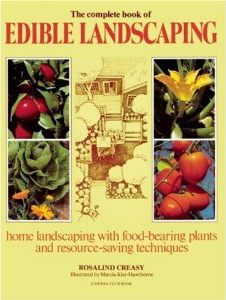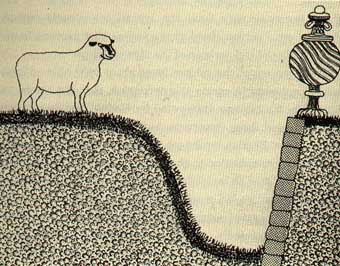
The Complete Book of Edible Landscaping
 Rosalind Creasy's The Complete Book of Edible Landscaping
was probably a cutting-edge book when it first came out in 1982, but
now I feel like the same information is presented in a better fashion in
various forest gardening books and in Robert Kourik's Designing and Maintaining Your Edible Landscape Naturally.
The most helpful two-thirds of Creasy's text consists of an
encyclopedia of plants recommended for edible landscaping and, again, I
feel like you'd get more information on that topic from Lee Reich's Uncommon Fruits Worthy of Attention and from Eric Toensmeier's Perennial Vegetables.
Rosalind Creasy's The Complete Book of Edible Landscaping
was probably a cutting-edge book when it first came out in 1982, but
now I feel like the same information is presented in a better fashion in
various forest gardening books and in Robert Kourik's Designing and Maintaining Your Edible Landscape Naturally.
The most helpful two-thirds of Creasy's text consists of an
encyclopedia of plants recommended for edible landscaping and, again, I
feel like you'd get more information on that topic from Lee Reich's Uncommon Fruits Worthy of Attention and from Eric Toensmeier's Perennial Vegetables.
However, Creasy's book is
still worth reading, particularly if you're an urban gardener who has
to make your tomatoes and cabbages blend in with the neighbor's perfect
lawn and clipped hedges. Creasy lists varieties of each species
that are not only productive, but that also are particularly pretty in
the landscape (although some of these varieties have fallen out of
favor and may now be hard to find).
And I should add the caveat that there is an updated version of Rosalind Creasy's book available, although there's no search-inside-the-book feature on Amazon, so I can't tell how much the  book
was revised and now much of the information stayed the same. I
also still mined quite a few thought-provoking tidbits from The Complete Book of Edible Landscaping,
despite having read many of the more-modern books on this theme.
For example, I'd heard of ha-has, but didn't realize that they were
originally imagined as a hidden barrier to keep deer, cattle, and sheep
in sight but out of the garden. And I'd never considered making
low-tech permeable paving similar to the way we built our ford,
by sinking cinderblocks in the ground and filling them with
gravel. Finally, Creasy's book got me thinking more scientifically
about summer shade and winter heat retention around our south-facing
bank of windows...but that's fodder for another post.
book
was revised and now much of the information stayed the same. I
also still mined quite a few thought-provoking tidbits from The Complete Book of Edible Landscaping,
despite having read many of the more-modern books on this theme.
For example, I'd heard of ha-has, but didn't realize that they were
originally imagined as a hidden barrier to keep deer, cattle, and sheep
in sight but out of the garden. And I'd never considered making
low-tech permeable paving similar to the way we built our ford,
by sinking cinderblocks in the ground and filling them with
gravel. Finally, Creasy's book got me thinking more scientifically
about summer shade and winter heat retention around our south-facing
bank of windows...but that's fodder for another post.
Want more in-depth information? Browse through our books.
Or explore more posts by date or by subject.
About us: Anna Hess and Mark Hamilton spent over a decade living self-sufficiently in the mountains of Virginia before moving north to start over from scratch in the foothills of Ohio. They've experimented with permaculture, no-till gardening, trailersteading, home-based microbusinesses and much more, writing about their adventures in both blogs and books.
Want to be notified when new comments are posted on this page? Click on the RSS button after you add a comment to subscribe to the comment feed, or simply check the box beside "email replies to me" while writing your comment.
